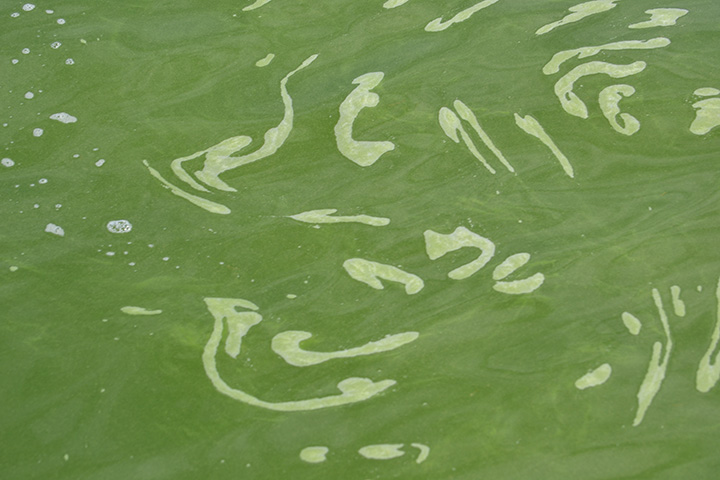Learn about harmful algal blooms and acidification on Thursday at GLMHC

Courtesy Photo Dr. Reagan Errera works with field samples. Photo courtesy Errera.
ALPENA — By now, you’ve heard about harmful algal blooms in the Great Lakes. To learn more about them, as well as new freshwater acidification research findings, attend Thursday’s lecture at the Great Lakes Maritime Heritage Center in Alpena.
The lecture, titled Stress to the System: Exploring Harmful Algal Blooms and Freshwater Acidification in the Great Lakes, will begin at 7 p.m. at the GLMHC, located at 500 W. Fletcher St. Doors open at 6:30 p.m.
Dr. Reagan Errera from the National Oceanic and Atmospheric Administration’s Great Lakes Environmental Research Laboratory will lead the presentation.
She will present findings from research that began last May in Thunder Bay. Acidification research has been going on in oceans for decades but just began in the Great Lakes.
“NOAA GLERLab is a partner that we are working with to do the freshwater acidification project here,” said Cassandra Sadler, resource protection specialist for Thunder Bay National Marine Sanctuary. “She’s going to be sharing the scientific details of the work that we’ve been doing.”

Courtesy Photo Harmful algal bloom on Lake Erie in August 2022. Photo courtesy of Reagan Errera.
“We’re really excited to have this kind of science in the sanctuary,” Sadler added. “Especially this baseline study for all of the Great Lakes because this research doesn’t only affect Thunder Bay; it affects all of the Great Lakes … This research hasn’t happened anywhere else in the Great Lakes yet.”
“The Laurentian Great Lakes support an economy exceeding $82 billion in wages annually and supply drinking water to more than 40 million people,” a press release from NOAA explained. “This valuable natural resource faces numerous challenges, including shifting land uses, climate induced acidification, increased aquatic temperatures, prevalent invasive species, harmful algal blooms (HABs), hypoxia, and loss of native populations. Exploring a few of these environmental stressors can provide insight into current and future scenarios that challenge the Great Lakes ecosystem while providing essential information to the scientific community, managers, and the public.”
Sadler explained that water samples are taken by divers deep below and at the surface of the water, then those samples are sent to a lab for analysis. Samples will be taken from both the Lady Michigan glass-bottom boat this year, as well as from NOAA research vessels. The samples are analyzed for the presence of cyanobacteria.
She said visitors on the Lady Michigan will have the opportunity to help collect water samples and be part of the research crew.
“So, they’ll be getting hands-on experience with the freshwater acidification study,” Sadler said.

Courtesy Photo Here a diagram showing the impacts of ocean acidification on marine life. Photo courtesy NOAA Pacific Marine Environmental Laboratory.
“Cyanobacterial harmful algal blooms (cHABs) occur in all five Great Lakes, with annual blooms occurring in Lake Erie, Lake Michigan (Green Bay), and Lake Huron (Saginaw Bay), in addition to the recent prevalence of blooms in Lake Superior,” the press release stated.
Blooms often contain toxins that can be detrimental to ecosystem.
“Understanding and interpreting the complex interactions between biological, chemical, and physical variables in coastal systems require versatile monitoring,” the release explained.
In her lecture, Errera will discuss “our current understanding of cHAB drivers, specifically in Lake Erie, and discuss some of the traditional and emerging technologies NOAA GLERL is employing to provide environmental data” to better understand algal blooms.
“Ocean acidification research has been going on for decades, but nobody has really focused on what’s happening in our freshwater systems,” Sadler said. “Freshwater absorbs carbon dioxide in the same way that oceans do. We see our waters warming and this is just a way to monitor those changes happening to our ecosystem … This is a multi-year project.”

Courtesy Photo Harmful algal bloom on Lake Erie in August 2022. Photo courtesy of Reagan Errera.
TBNMS teamed up to establish a monitoring program for acidification in the Great Lakes. Preliminary data has been able to detect changes in the inorganic carbonate system, especially near the unique sink hole region in Lake Huron. In addition, shifts in the coastal acidification may be occurring following storm events. This dataset is the first step in providing an understanding of the inorganic carbonate chemistry system in the Great Lakes.
- Courtesy Photo Dr. Reagan Errera works with field samples. Photo courtesy Errera.
- Courtesy Photo Harmful algal bloom on Lake Erie in August 2022. Photo courtesy of Reagan Errera.
- Courtesy Photo Here a diagram showing the impacts of ocean acidification on marine life. Photo courtesy NOAA Pacific Marine Environmental Laboratory.
- Courtesy Photo Harmful algal bloom on Lake Erie in August 2022. Photo courtesy of Reagan Errera.







